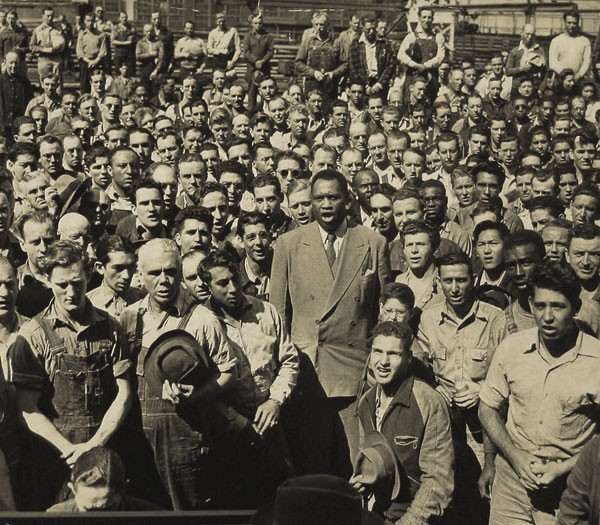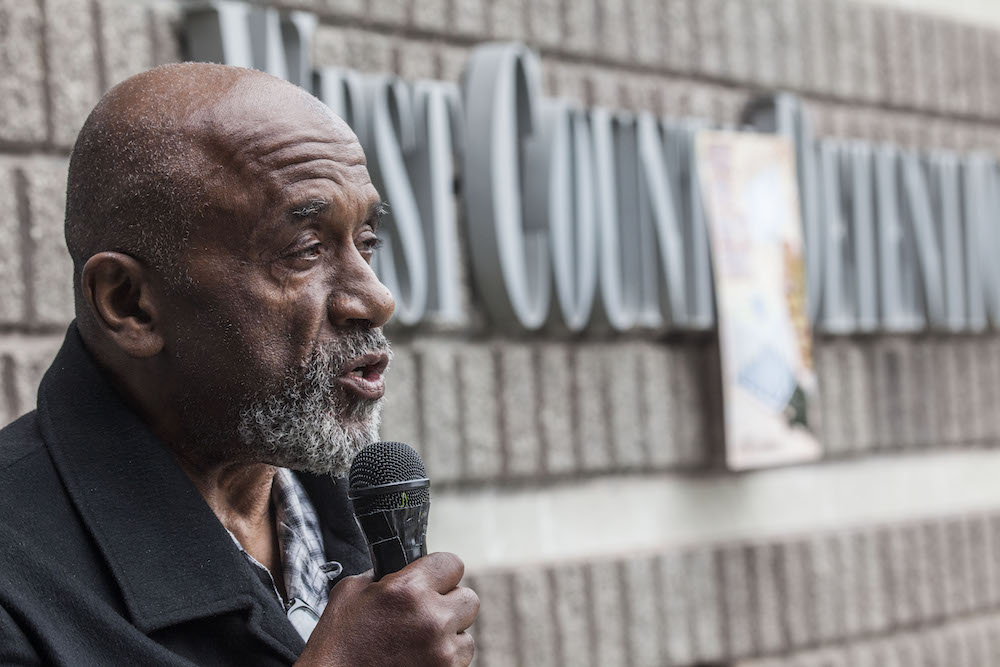

<aside> 📅 Join MMHI and MuslimARC this Tuesday, February 23 from 5:30-7pm for part 2 of their Anti-Racism 101 workshop, Implicit Bias and Microaggressions. RSVP now to reserve a spot at the workshop. Details.
</aside>

Entertainer Paul Robeson sings to laborers working at the Moore shipyards in Oakland, California. September 21, 1942 (Oakland Tribune)
Long before the influx of immigrant Muslims into Silicon Valley, the heart of the Muslim community in the Bay Area was centered in Oakland and San Francisco. During the Great Migration, hundreds of thousands of Black Americans left the Jim Crow South for cities such as Richmond and Oakland in California, often finding work in the Kaiser Shipyards during the shipbuilding boom of World War II. Roughly 1.5 million Black Americans left the Jim Crow South, of which an estimated 339,000 people moved to the western half of the country, according to the Schomburg Center for Research in Black Culture.
According to the U.S. Census, between 1940 and 1950, the Black population in Oakland grew over 400% as Black Americans seeking better job opportunities moved to the Bay Area, building communities and institutions by carving out an enclave of their own in a predominantly white area. Among the many obstacles preventing social integration and economic sustainability for the Black community was intense de facto segregation and anti-housing sentiment, supported by the cities of Albany, Berkeley and Oakland, as well as institutions like the University of California, Berkeley.
When WWII brought blacks to the East Bay, whites fought for segregation
In 1942, Elijah Muhammad, the national leader of the Nation of Islam, was charged and arrested for sedition for evading the World War II draft and for encouraging his followers to resist war recruitment efforts as part of the organization's nonviolent anti-war politics. Following his release in 1946, the Nation of Islam sought to increase recruitment in the Black community. The post-war period was characterized by limited economic opportunities for the Black community, as well as white flight, urban decay, and redlining, further marginalizing Black communities in Oakland, Richmond, and San Francisco.
In 1959, the Islamic Center of San Francisco was founded at 400 Crescent Avenue, making it the first masjid in the San Francisco Bay Area. That same year, Malcolm X founded the first Nation of Islam mosque in Oakland on Henry Street in West Oakland. Prior to this, the closest major masjid was the Muslim Mosque Association (Jame Masjid) in Sacramento, which was founded by Muslim immigrants from the Indian subcontinent in 1947 during the partition of British India. Today, it is the oldest masjid west of the Mississippi.

Islamic Center of San Francisco • Website • Donate

Muslim Mosque Association on V Street, Sacramento • Website • Donate
The Nation of Islam and its prohibitive stance towards "bad influences" in the Black community—such as drugs and alcohol—attracted followers among the Black community of Oakland and San Francisco who sought to uplift the Black condition. The Nation's strong focus on Black self-sufficiency, nonviolence, and spirituality made it stand out among the diverse array of Black political and social organizations that would emerge during the Civil Rights Movement, such as the Black Liberation Army, the Black Panther Party, and the Student Nonviolent Coordination Committee, which were generally less religiously inclined and had pan-Africanist, socialist, and Marxist-Leninist leanings.
At the height of the Civil Rights Movement, the East Bay became the hotbed of activism in the Bay Area. In 1963, Malcolm X visited UC Berkeley campus two years before his assassination, while the Black Panther Party was founded in 1966 in close proximity to Berkeley. That same year, Muhammad Ali had refused to be drafted in into the Vietnam War, contributing to the social tension at the time in the midst of the Free Speech Movement.
Watch: Malcolm X at UC Berkeley in 1963
These times made being a Black student at UC Berkeley rather turbulent. Abdul Raoof Nasir, who now teaches Islamic studies at Masjidul Waritheen and has worked with Muslim inmates in state prisons, describes his conversion to Islam while at UC Berkeley in an interview with Professor Hatem Bazian. As a student at UC Berkeley intending to study architecture, he instead chose to focus on Black studies after the ethnic studies movement, accepting Islam in 1969 after being given da'wah by a Nation of Islam member. Nasir notes the dearth of Muslim organizations in the East Bay following the 1965 Immigration Act, and that the Muslim Student Association at Berkeley had never approached him for da'wah.

Photo: David Bacon
<aside> 🔦 Spotlight Imam Abu Qadir Al-Amin has been the Resident Imam of the San Francisco Muslim Community Center since 1981, after he was appointed by Imam Warith Deen Muhammad.
</aside>
Before his passing in 1975, Elijah Muhammad designated his son Warith Deen as his successor. Imam W.D. Muhammad began a massive undertaking of reform within the Nation of Islam, which ultimately culminated in what has been called the largest mass conversion of people to (Sunni) Islam in North America, and quite possibly the world.